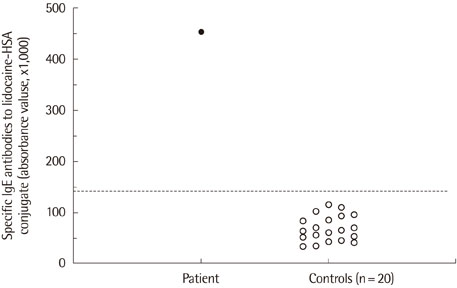Lidocaine anaphylaxis and lidocaine-specific immunoglobulin E measurement
- Affiliations
-
- 1Department of Internal Medicine, Inha University School of Medicine, Incheon, Korea. cwkim1805@inha.ac.kr
- KMID: 2263068
- DOI: http://doi.org/10.4168/aard.2013.1.1.98
Abstract
- Although local anesthetics can cause adverse drug reactions (ADRs), most ADRs to local anesthetics are from vasovagal, toxic, or anxiety reactions, while immunoglobulin E (IgE)-mediated anaphylaxis is extremely rare. We report a case of IgE-mediated anaphylactic reaction to lidocaine. A 27-year-old male patient who had two episodes of anaphylactic reactions after local injection of lidocaine was referred to our clinic for the safe use of local anesthetics for the subsequent dental procedure. Skin prick and intradermal tests were performed with amide local anesthetics; lidocaine, bupivacaine, mepivacaine, and ropivacaine. Lidocaine and mepivacaine showed positive response in prick test, and lidocaine, mepivacaine, and bupivacaine showed positive reactions in intradermal test. Only ropivacaine showed negative response both in prick and in intradermal test, and the patient was successfully treated with it. To detect serum-specific IgE, we prepared lidocaine-human serum albumin (HSA) conjugate. Enzyme-linked immunosorbent assay result showed high level of specific IgE to lidocaine-HSA conjugate in serum of the patient. This case suggests that local anesthetics can elicit specific IgE-mediated allergic reactions, and both skin prick and intradermal test should be performed in case of suspected IgE-mediated allergic response to local anesthetics.
Keyword
MeSH Terms
-
Amides
Anaphylaxis
Anesthetics, Local
Anxiety
Bupivacaine
Drug Toxicity
Enzyme-Linked Immunosorbent Assay
Humans
Hypersensitivity
Immunoglobulin E
Immunoglobulins
Intradermal Tests
Lidocaine
Male
Mepivacaine
Serum Albumin
Skin
Amides
Anesthetics, Local
Bupivacaine
Immunoglobulin E
Immunoglobulins
Lidocaine
Mepivacaine
Serum Albumin
Figure
Cited by 3 articles
-
Overview of anaphylaxis in Korea: diagnosis and management
Gwang Cheon Jang, Yoon-Seok Chang, Sun Hee Choi, Woo-Jung Song, Soo-Young Lee, Hae-Sim Park, Hye-Ryun Kang, Yeong-Min Ye, Hyun-Jung Jin, Mi Yong Shin, Soo-Jin Lee, Hye One Kim, Jihyun Kim, Jae-Woo Jung, Hee-Bom Moon, Youngmin Ahn
Allergy Asthma Respir Dis. 2013;1(3):181-196. doi: 10.4168/aard.2013.1.3.181.Vitamin K-induced anaphylaxis
Hyo-Hoon Kim, Min-Hye Kim, Shin-Woo Kim, Hyun-Ha Chang, Hye-In Kim, Ju-Young Jeong, Sun Jin, Jung-Wha Park, Hye-Jin Jung, Jong-Myung Lee
Allergy Asthma Respir Dis. 2014;2(2):146-149. doi: 10.4168/aard.2014.2.2.146.Delayed urticaria caused by lidocaine in a child
Geun-Mi Park, Hae Won Han, Jae Yeon Kim, Keum Hee Hwang, Eun Lee, Song-I Yang, Young-Ho Jung, Soo-Jong Hong, Ju-Hee Seo, Jinho Yu
Allergy Asthma Respir Dis. 2014;2(4):298-301. doi: 10.4168/aard.2014.2.4.298.
Reference
-
1. Harboe T, Guttormsen AB, Aarebrot S, Dybendal T, Irgens A, Florvaag E. Suspected allergy to local anaesthetics: follow-up in 135 cases. Acta Anaesthesiol Scand. 2010. 54:536–542.
Article2. Gall H, Kaufmann R, Kalveram CM. Adverse reactions to local anesthetics: analysis of 197 cases. J Allergy Clin Immunol. 1996. 97:933–937.
Article3. Fulcher DA, Katelaris CH. Anaphylactoid reactions to local anaesthetics despite IgE deficiency: a case report. Asian Pac J Allergy Immunol. 1990. 8:133–136.4. Noormalin A, Shahnaz M, Rosmilah M, Mujahid SH, Gendeh BS. IgE-mediated hypersensitivity reaction to lignocaine: a case report. Trop Biomed. 2005. 22:179–183.5. Cuesta-Herranz J, de las Heras M, Fernandez M, Lluch M, Figueredo E, Umpierrez A, et al. Allergic reaction caused by local anesthetic agents belonging to the amide group. J Allergy Clin Immunol. 1997. 99:427–428.6. Grzanka A, Misiolek H, Filipowska A, Miskiewicz-Orczyk K, Jarzab J. Adverse effects of local anaesthetics: allergy, toxic reactions or hypersensitivity. Anestezjol Intens Ter. 2010. 42:175–178.7. Prieto A, Herrero T, Rubio M, Tornero P, Baeza ML, Velloso A, et al. Urticaria due to mepivacaine with tolerance to lidocaine and bupivacaine. Allergy. 2005. 60:261–262.
Article8. Fuzier R, Lapeyre-Mestre M, Mertes PM, Nicolas JF, Benoit Y, Didier A, et al. Immediate- and delayed-type allergic reactions to amide local anesthetics: clinical features and skin testing. Pharmacoepidemiol Drug Saf. 2009. 18:595–601.
Article9. Lee SM, Song WJ, Yang MS, Lee SH, Kwon JW, Kim TW, et al. A case of lidocaine anaphylaxis. Korean J Asthma Allergy Clin Immunol. 2006. 26:249–253.10. In JH, Choi JW, Joo JD, Kim DW, Jung HS, Park HJ. Intraoperative anaphylaxis after local infiltration of lidocaine for dental treatment under general anesthesia: a case report. Korean J Anesthesiol. 2008. 55:395–398.
Article11. Lee MY, Park KA, Yeo SJ, Kim SH, Goong HJ, Jang AS, et al. Bronchospasm and anaphylactic shock following lidocaine aerosol inhalation in a patient with butane inhalation lung injury. Allergy Asthma Immunol Res. 2011. 3:280–282.
Article12. Sim SJ, Han JD, Ryu WS, Lee DW, La DJ, Park CW. Anaphylactic reaction after topical Lidocaine anesthesia during bronchoscopy. J Asthma Allergy Clin Immunol. 1999. 19:219–223.13. Kwon YS, Kwon YI, An DA, Kim IH. A case report of asthmatic breathing with lidocaine. Korean J Anesthesiol. 1981. 14:492–494.
Article14. Yoon BK, Ban HJ, Kwon YS, Oh IJ, Kim KS, Kim YI, et al. A case of tracheal carcinoma diagnosed by rigid bronchoscopy in lidocaine anaphylaxis patient. Tuberc Respir Dis. 2009. 67:140–144.
Article15. Celik G, Pichler WJ, Adkinson NF. Adkinson NF, Middleton E, editors. Drug allergy. Middleton's allergy: principles & practice. 2009. 7th ed. Philadelphia: Mosby/Elsevier;1025–1226.16. Kim CW, Choi SY, Park JW, Hong CS. Respiratory allergy to the indoor ant (Monomorium pharaonis) not related to sting allergy. Ann Allergy Asthma Immunol. 2005. 94:301–306.
Article17. Simons FE. Anaphylaxis. J Allergy Clin Immunol. 2010. 125:2 Suppl 2. S161–S181.
Article
- Full Text Links
- Actions
-
Cited
- CITED
-
- Close
- Share
- Similar articles
-
- Intraoperative anaphylaxis after local infiltration of lidocaine for dental treatment under general anesthesia: A case report
- Optimal Dose of Lidocaine for the Prevention of Pain on Injection of Diazepam
- A Case of Tracheal Carcinoma Diagnosed by Rigid Bronchoscopy in Lidocaine Anaphylaxis Patient
- Anaphylactic reaction after topical Lidocaine anesthesia during bronchoscopy
- The Effect of Topical Application of Lidocaine Cream before Arteriovenous(AV) Fistula Puncture on Pain and Anxiety Among Hemodialysis Patients


